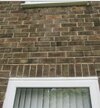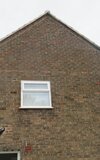- Joined
- 1 Jul 2023
- Messages
- 11
- Reaction score
- 0
- Country

Hi,
I recently posted about a house I'm in the process of buying, which is displaying classic signs of lintel failure above a few windows and primarily the back door.
My question is, how risky would this be considered as a diy job?
I've watched several videos and read multiple tutorials about lintel replacement and I'm very confident in undertaking this task.
I've received quotes for a platform, acrow bars and strong boys, as well as sizing windows and such.
I've read over building regulations, and believe I have a firm understanding as to what I'm getting myself into and I still don't feel like it's as big of a task as some family/friends are making it out to be.
To my understanding, and what has been mentioned on here previously, the lintels support a triangular formation of bricks above, and providing they're supported sufficiently prior to the removal of brickwork, there's small, if any, risk of failure in this triangular structure?
From here onwards, to my understanding, it effectively becomes a matter of removing the brickwork beneath the strong boys, removing the older lintel, and then replacing it with a newer lintel and if required providing a new cavity tray.
Once this is done, building back the bricks removed and leaving supports in place for 24hrs prior to removal to ensure that the mortar sets without any compaction and potential structural deficiencies where the mortar has compacted.
Can I ask, is my understanding of this accurate and how feasible is this?
I'm quite handy, although never having done anything of this nature previously.
My ambition is ultimately to buy and restore properties in future, so it's inevitably something I'll be exposed to and will be required to handle.
Thanks in advance for any support and answers.
Adam.
I recently posted about a house I'm in the process of buying, which is displaying classic signs of lintel failure above a few windows and primarily the back door.
My question is, how risky would this be considered as a diy job?
I've watched several videos and read multiple tutorials about lintel replacement and I'm very confident in undertaking this task.
I've received quotes for a platform, acrow bars and strong boys, as well as sizing windows and such.
I've read over building regulations, and believe I have a firm understanding as to what I'm getting myself into and I still don't feel like it's as big of a task as some family/friends are making it out to be.
To my understanding, and what has been mentioned on here previously, the lintels support a triangular formation of bricks above, and providing they're supported sufficiently prior to the removal of brickwork, there's small, if any, risk of failure in this triangular structure?
From here onwards, to my understanding, it effectively becomes a matter of removing the brickwork beneath the strong boys, removing the older lintel, and then replacing it with a newer lintel and if required providing a new cavity tray.
Once this is done, building back the bricks removed and leaving supports in place for 24hrs prior to removal to ensure that the mortar sets without any compaction and potential structural deficiencies where the mortar has compacted.
Can I ask, is my understanding of this accurate and how feasible is this?
I'm quite handy, although never having done anything of this nature previously.
My ambition is ultimately to buy and restore properties in future, so it's inevitably something I'll be exposed to and will be required to handle.
Thanks in advance for any support and answers.
Adam.




